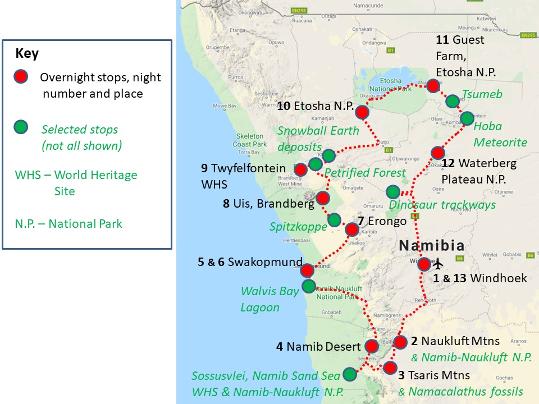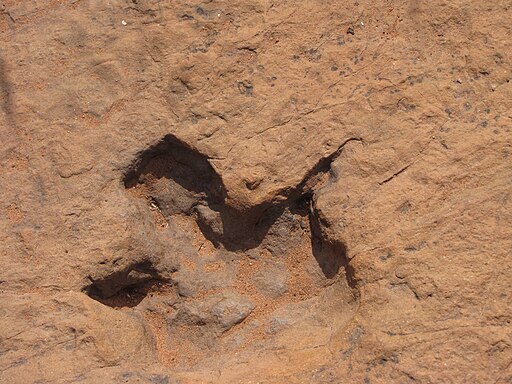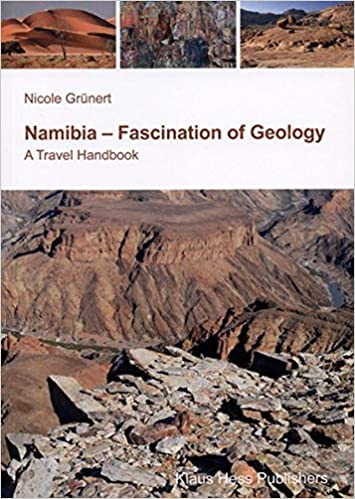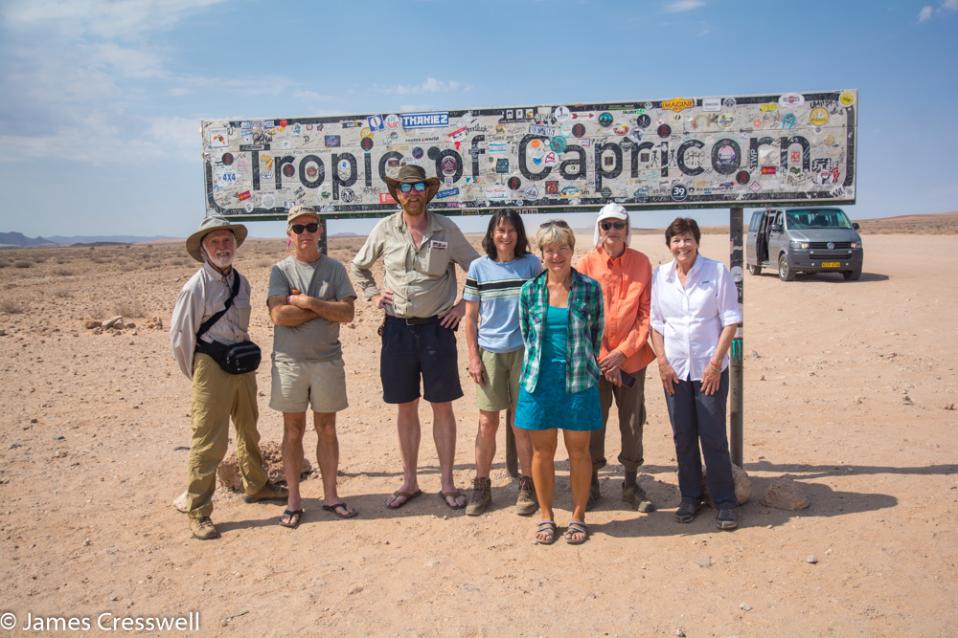Northern Namibia
A Geological Safari
Windhoek to Windhoek
Exclusive small group tour. Number of participants: 4-12
30 May - 12 June 2024 *FULL*
14 Days/13 Nights
£3,495
* * * * *
29 May - 11 June 2025 *12 spaces*
14 days/13 nights
£TBC
Prices are per person, based on 2 people sharing a room, bed & breakfast accommodation, with dinner when in lodges and camps (7 nights). Single supplement applies, please make contact for details.
Includes 2 World Heritage Sites and 2 National Parks
Namibia is one of the most interesting geological destinations in the world. It is home to the world's oldest desert with giant dunes, the world's largest iron meteorite, the world's oldest shelly fossils, giant former volcanoes, deposits from a the Snowball Earth global glaciation, and the remnants of continental collisions. Added to this is incredible wildlife in some of Africa's best national parks, and World Heritage rock engravings.
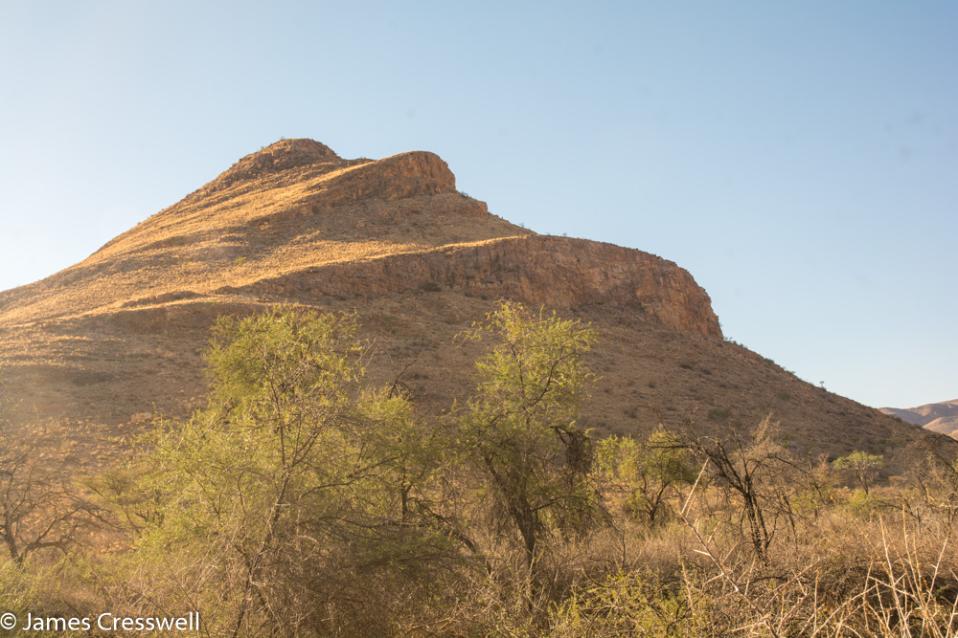
Imbricated thrust faults in the Naukluft Mountains (Day2)
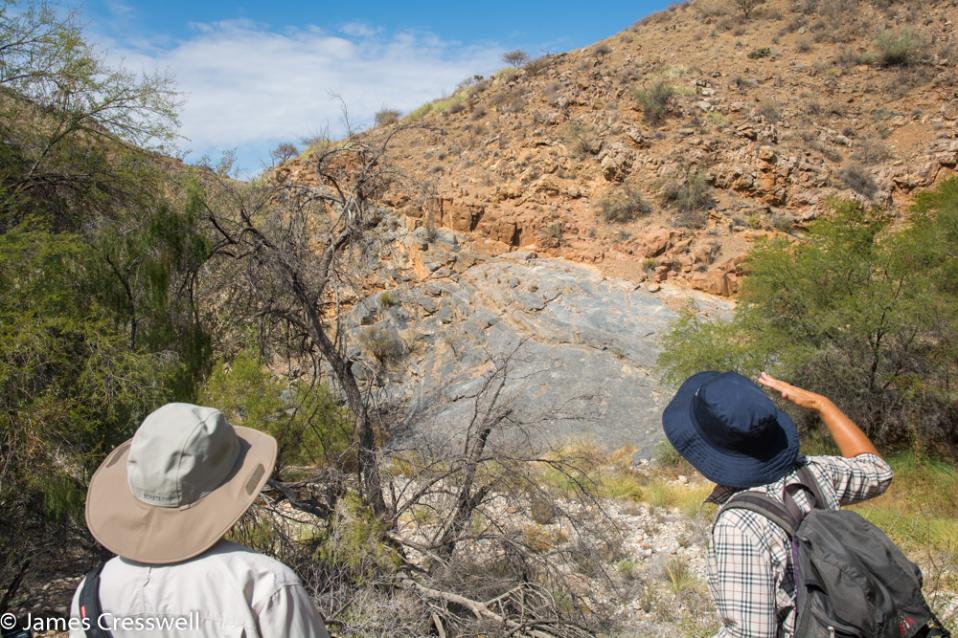
The main basal thrust plain of the Naukluft fault and the "Sole dolomite" in the Namib-Naukluft National Park (Day 3)
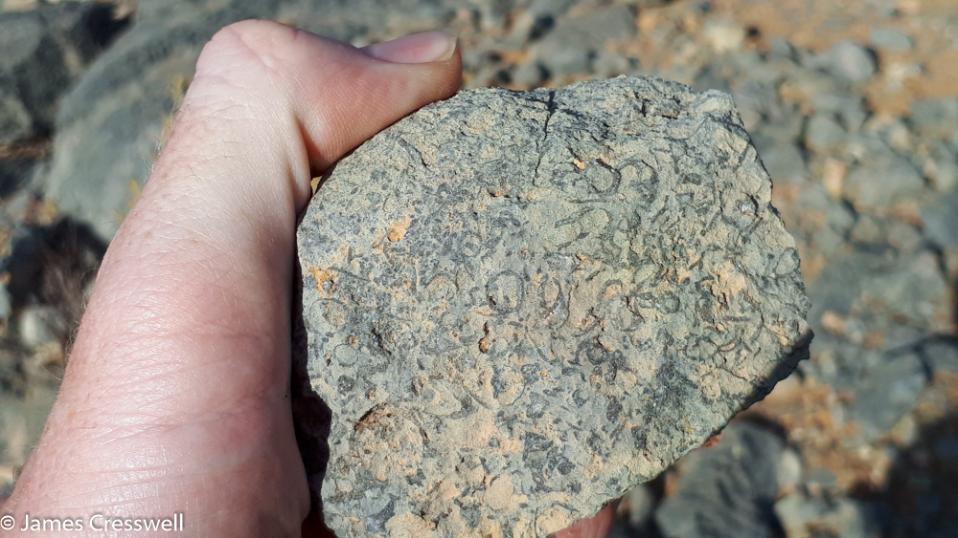
The oldest shelly fossils in the world, Namacalathus, in the Tsaris Mountains (Day 3)
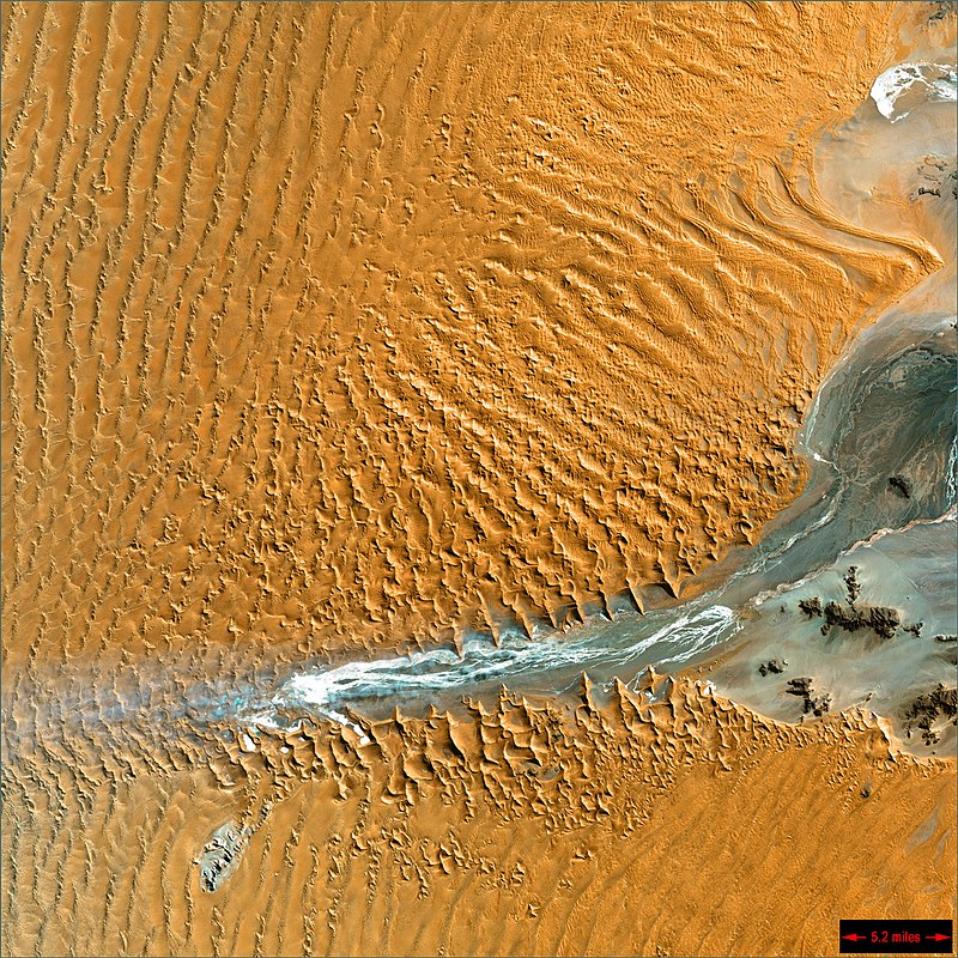
A Landsat image of the Tsauchab ephemeral river cutting 45 km into the Namib Desert dune field, terminating in the Sossusvlei Pan (Day 4) ©NASA
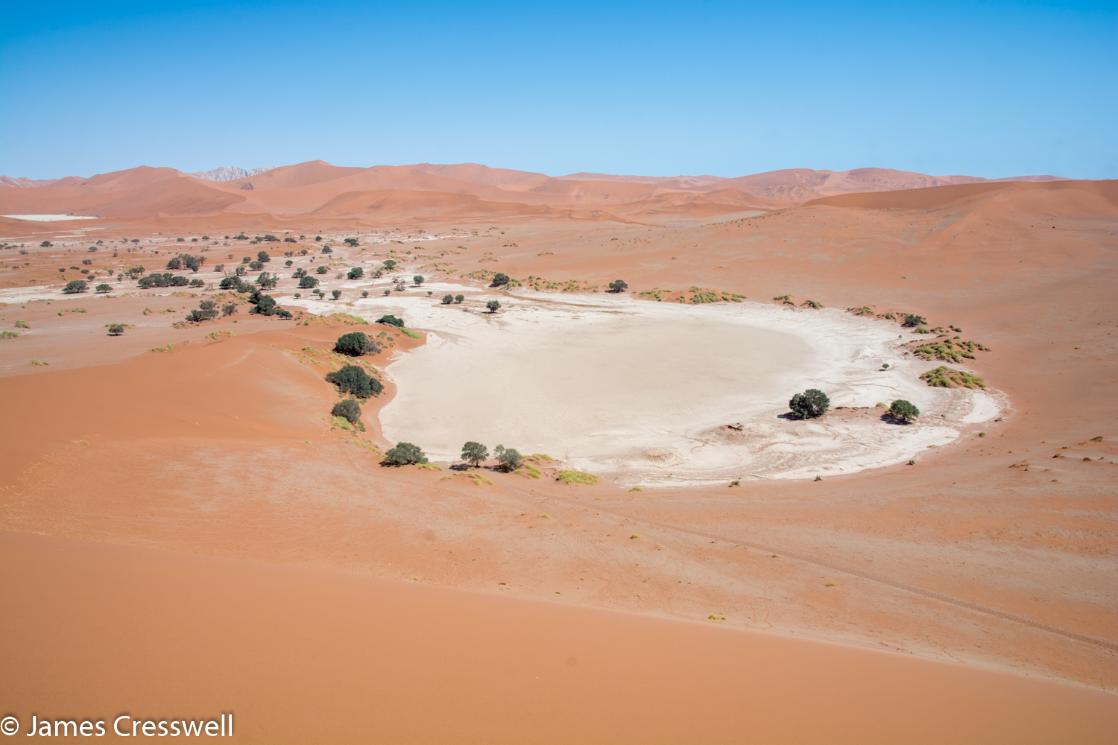
The Soussusvlei Pan, a clay and salt pan, and as far as the ephemeral Tsauchab river gets to the sea, however subsurface water does continue under the dunes(Day 4)
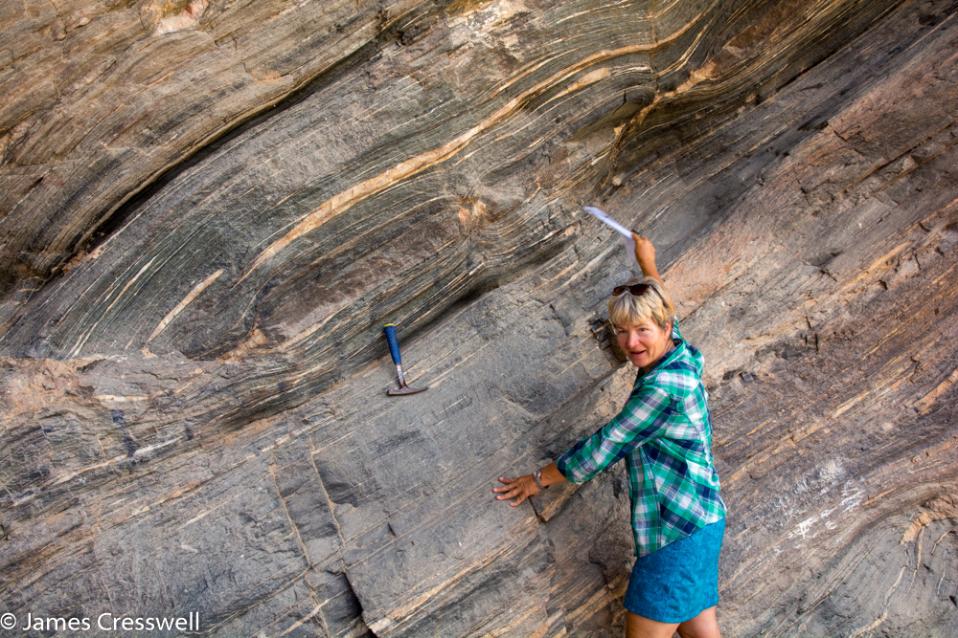
Nicole points out boudins, in rock that formed as basalt in the splitting of Rodinia 900 million years ago, but was later converted to amphibolite in the Pan-African orogeny (Day 5)
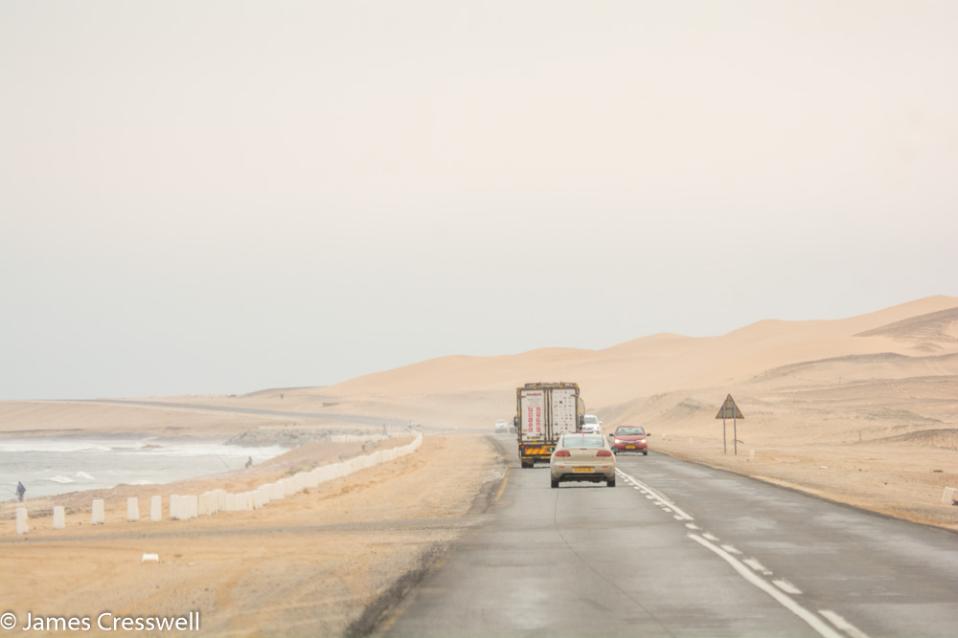
The Namib Desert meets the coast. This is the road between Swakopmund and Walvis Bay. The cold Benguela current leads to the area being enveloped in thick fog for around half of the year (Day 6).
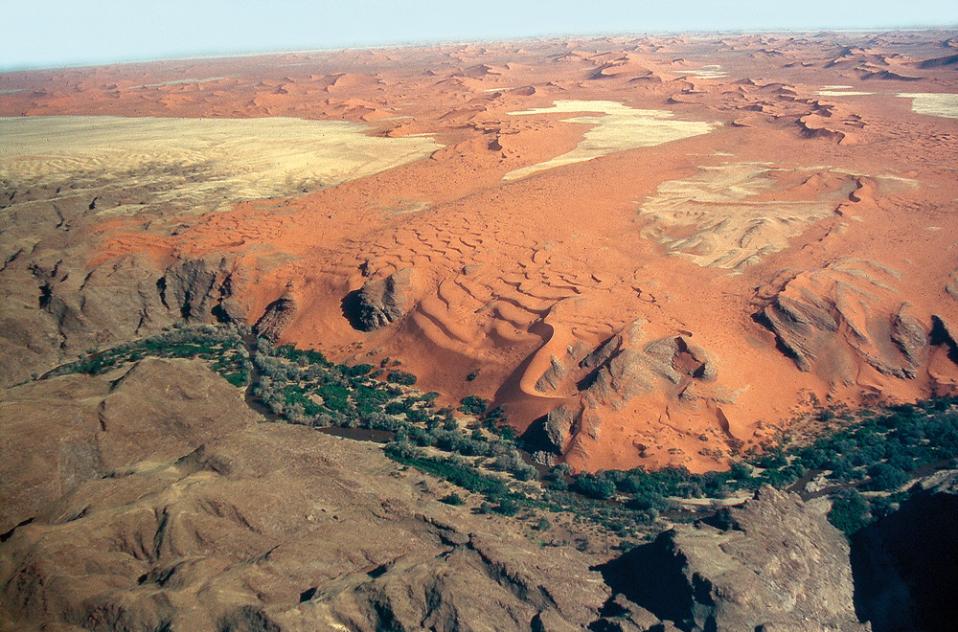
A view from the optional scenic flight over the Namib Desert (Day 6)
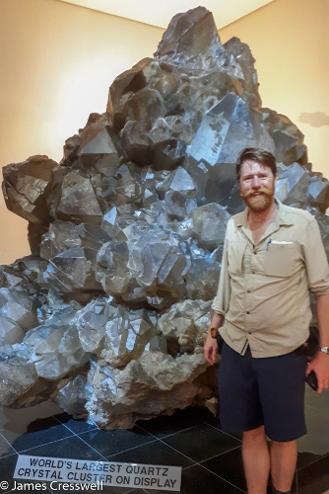
James Cresswell with the world's largest quartz crystal cluster on displayin the in the Kristall Gallerie in Swakopmund (Day 7)
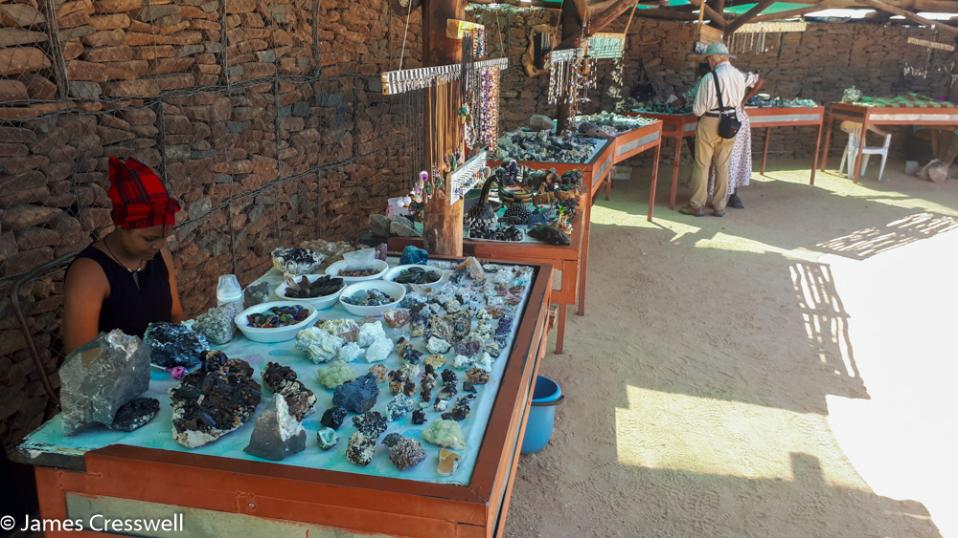
Mineral vendors (Day 7)
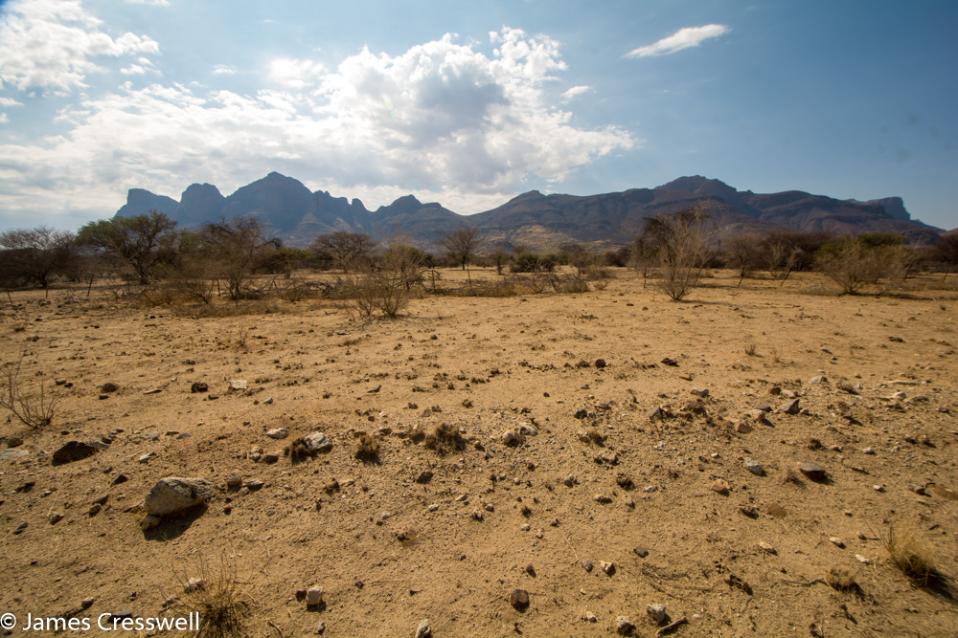
The eroded remains of the Erongo volcano that was emplaced by the Tristan hotspot during the opening of the South Atlantic (Day 7)
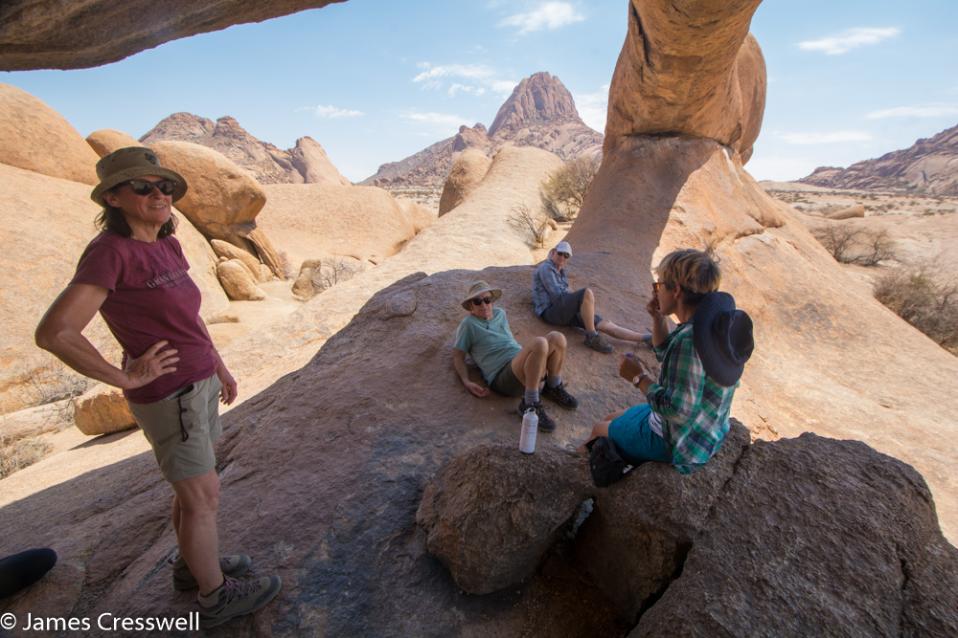
An arch of granite with Spitzkoppe mountain in the background (Day 8)

A pegmatite vein with large tourmaline, quartz and mica crystals (Day9)
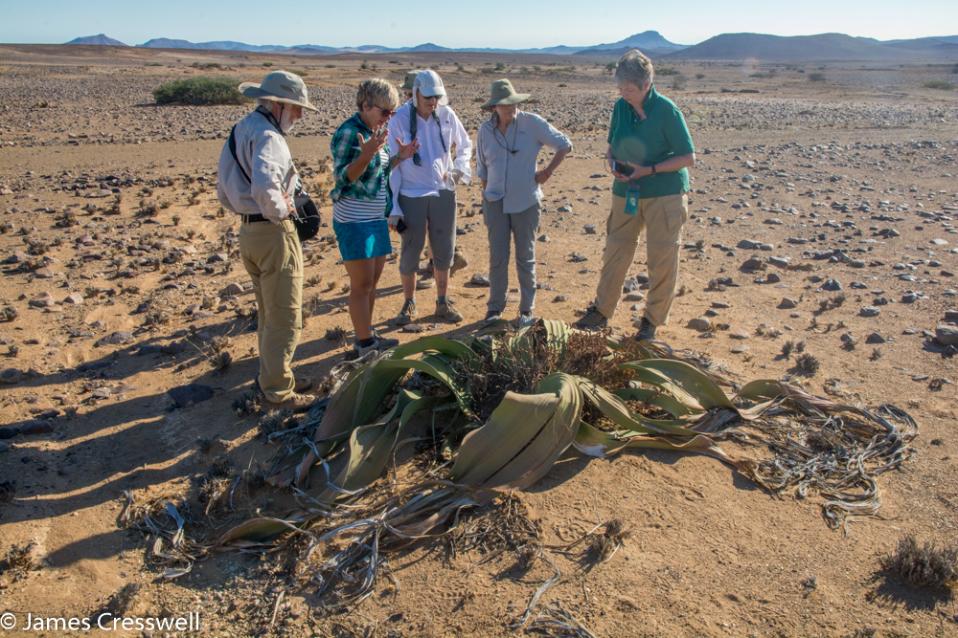
Viewing a Welwitschia the national plant of Namibia (Day 9)
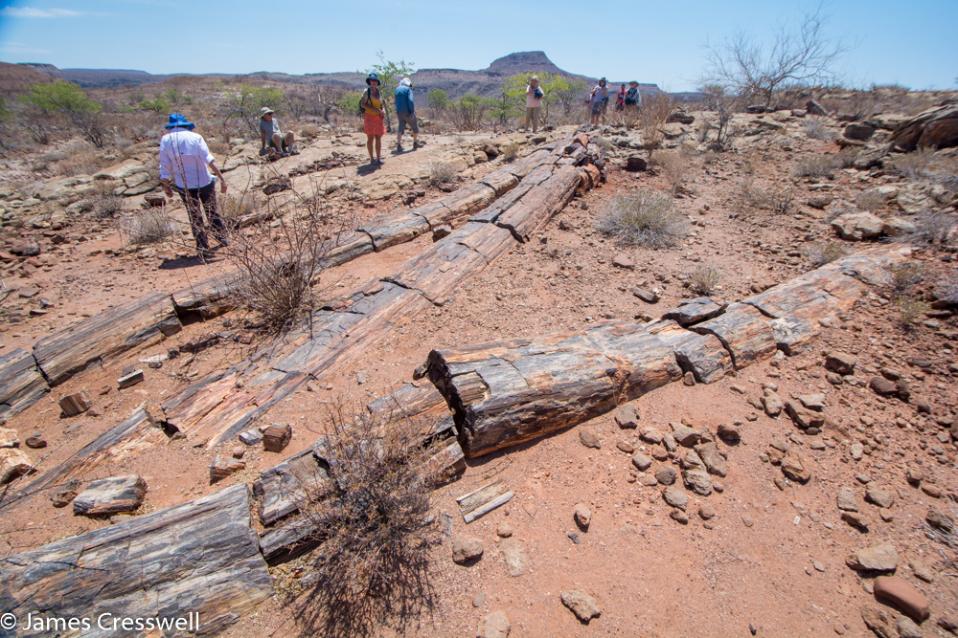
Permian-aged petrified wood in Damaraland (Day 10)
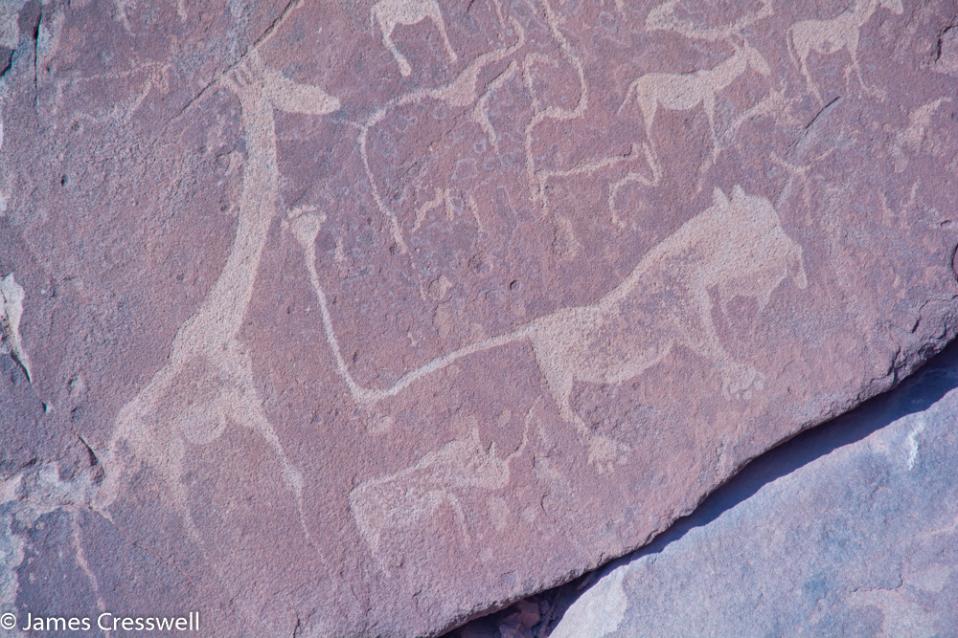
The Man-Lion rock engravingin the Twyfelfontein World Heritage Site(Day 10)
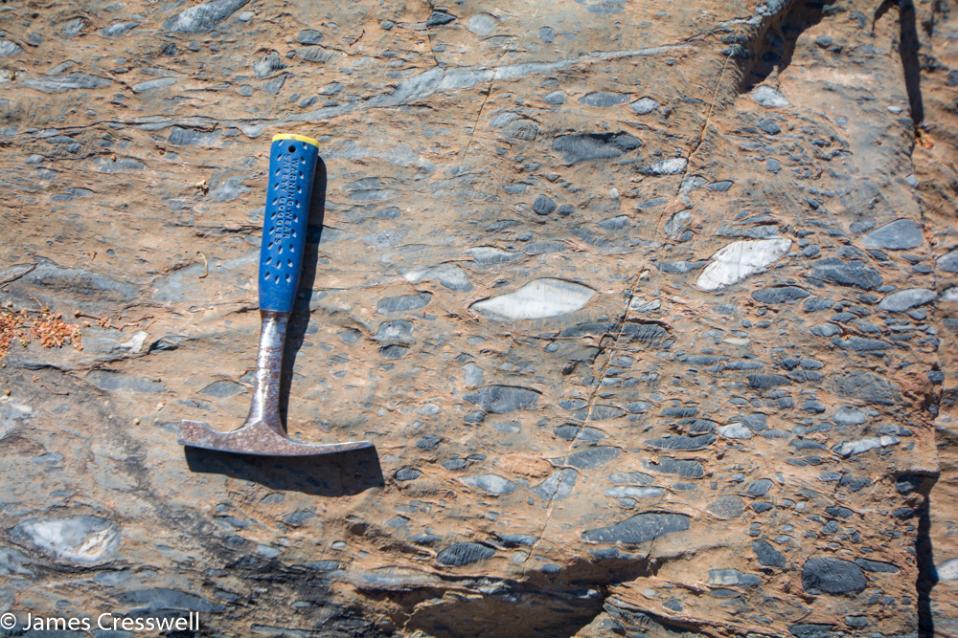
Drop-stone Snowball Earth deposits (Day 11)

An African Elephant in Etosha National Park (Day 12). For more wildlife photos from Etosha please see the Wildlife Photo Gallery

Tsumeb mine museum just up the street from the now abandoned Tsumeb Mine. The mine was one of the world’s best mineral mines (Day 13)
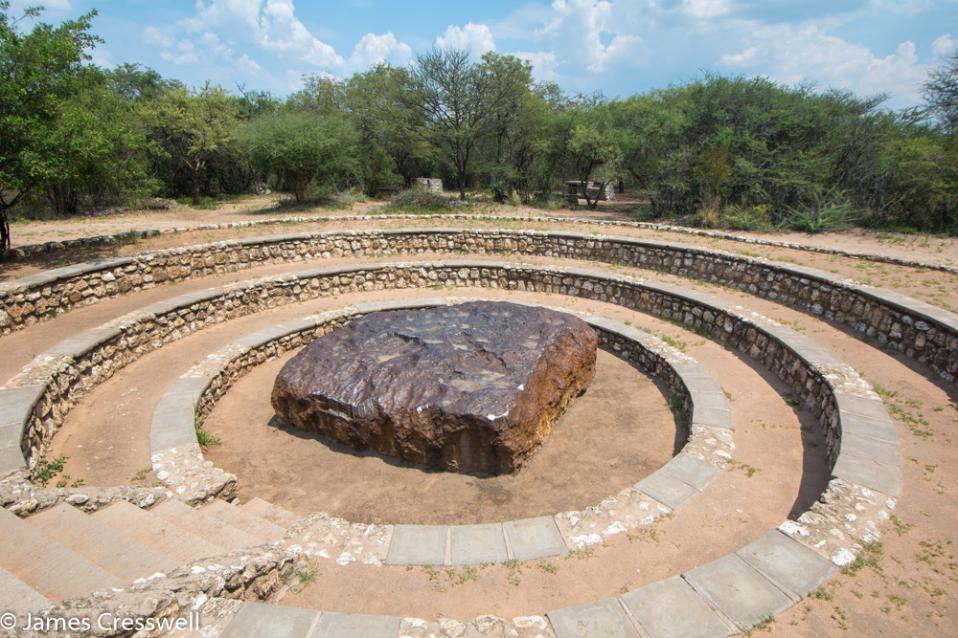
The Hoba meteorite, the world's largest discovered iron meteorite(Day 13)
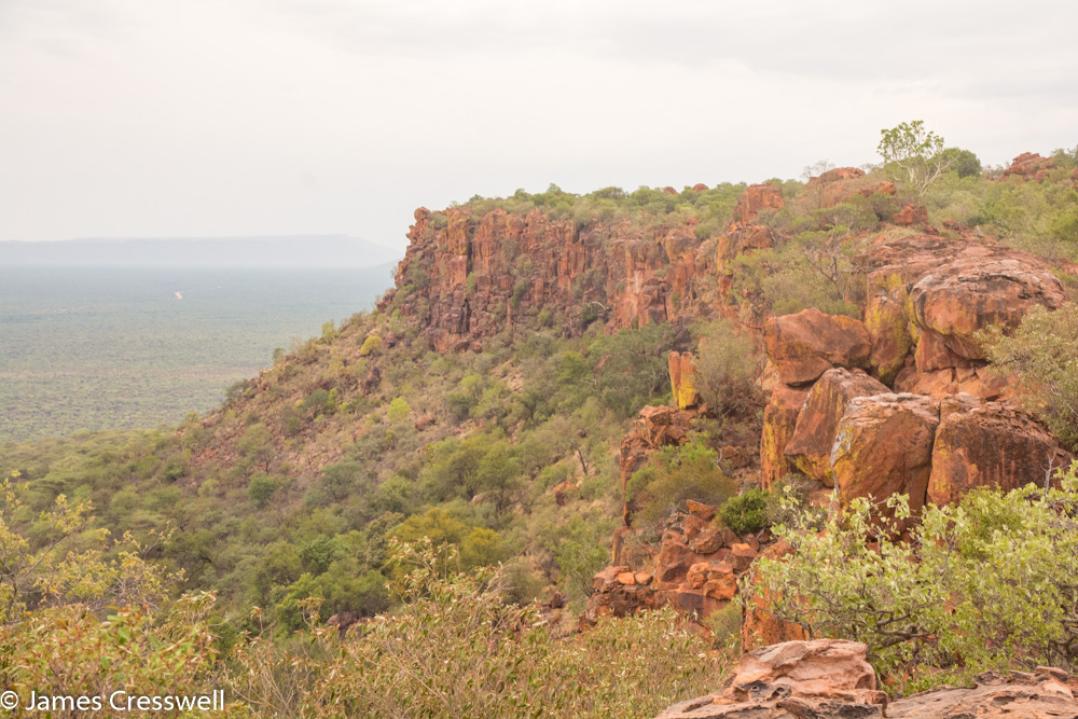
Waterberg Plateau National Park (Day 13)
A dinosaur footprint at Otjihaenamaparero National Monument (Day 14)
Itinerary
Day 1: Arrival in Windhoek, the capital of Namibia. An airport transfer will be arranged for you, taking you directly to the hotel. The first night of the tour will be spent at the Avani Hotel in Windhoek city centre, offering fantastic views of the city. At lunchtime, your geologist guide, Nicole Grünert, will meet you at the hotel. The hotel has an on-site restaurant and you will be able to have your evening meal here.
Day 2: En-route to the Naukluft Mountains. Today we set off from Windhoek driving in a south-westerly direction towards the Naukluft mountains. Our first stop is the Aris Quarry. Here we see Tertiary-aged phonolite lava that is being quarried for road aggregate. The lava was produced by the Discovery Hotspot that is today situated under Gough Island in the South Atlantic, and, if you crack it with a hammer, it still contains water. Our next stop near Kobos is at an outcrop of 1-billion-year-old granite, where we learn about the way it weathers in a dry, arid environment. In the afternoon we arrive in the Naukluft Mountains, at Bullsport Guestfarm where we will spend the night. The Naukluft Mountains consist of different units of rock that have been thrust over each other (a nappe complex). From the farm we take a walk to enjoy the stunning local scenery. The area also has some wildlife and, if we are lucky, we may see baboons, mountain zebra and antelope. Approximate driving time: 4 hours
Day 3: The Naukluft Thrust Fault and the world’s oldest shelly fossils. Our first stop of the day is in the eastern-most portion of the Namib-Naukluft National Park, a huge national park that encompasses a very large area of south-western Namibia. Here we take a walk to see the main basal thrust plane of the Naukluft Fault. The fault is of great interest to geologists because carbonate rocks at its base, known as the ‘sole dolomite’, have lubricated it, allowing rock units to be pushed great distances over gently dipping thrust faults. We then leave the national park and drive on to the nearby Tsaris Mountains to reach a guest lodge (Zebra River Lodge) where we will spend the night. In the vicinity of the lodge is an extremely important geological location where we see the oldest shelly fossils in the world. These fossils are called Namacalathus, and their discovery caused the Precambrian (Edicarian)/ Cambrian boundary to be revised back in time. We also see beautiful stromatolite fossils in the same rocks. Approximate driving time: 2 hours
Day 4: Sossusvlei Pan and Dunes, in both the Namib Sand Sea World Heritage Site and the Namib-Naukluft National Park. Today we visit one of Namibia’s great natural wonders, the Sossusvlei Pan and the surrounding red desert sand dunes. The area is so wonderous that it has been designated a UNESCO World Heritage Site. Sossusvlei literally translates to “dead-end marsh”. It is a clay pan, and is the terminus of the Tsauchab ephemeral river, which is prevented from flowing all the way to the sea by the sand dunes of the Namib Desert. When occasional rains occur in the Naukluft Mountains, the source of the river, the Tsauchab becomes a rapid-running strong river in a matter of hours. This force is enough to keep a 45km long river valley free of sand dunes (see NASA image to the left). The force of the river over the last 2 million years has also carved the Sesriem Canyon. Our first stop is the canyon which we visit before, re-entering the Namib-Naukluft National Park, and journeying the 65 km through the sand dunes to reach the Soussuvlei pan. Once at the pan, we are likely to see oryx and springboks, and we are able to climb one of the dunes for magnificent views. We will spend the night in a luxury guest lodge (Namib Desert Lodge) near the dune fields. Total driving time: c. 4 hours
Day 5: Fossilzed dunes, the Tropic of Capricorn, boudins and a 770-million-year-old ophiolite. Our first stop is within the grounds of our lodge to view fossilized sand dunes. These dunes now form cliffs that show that the Namib Desert has continuously existed at this site for at least the last 20 million years, making it the oldest desert in the world. We then journey on and make a photo stop as we cross over the Tropic of Capricorn. The next stop is to see some impressive boudin structures which have a complex origin. The rock they are made from was originally basalt, formed as the ancient super continent Rodinia rifted apart 900 million years ago. This basalt was then crumpled up and metamorphosed to amphibolite, when the Kalahari and Congo cratons collided 550 million years ago in the pan-African orgogeny. The following stop, also a stop relating to the pan-African orogeny, is even more interesting. The rock we see here is part of a 300km long (but only 0.5–3km wide) belt that lies between the Kalahari and Congo Cratons. This belt is known as the Matchless Belt and is thought to be an ophiolite (ocean crust that has been obducted onto continental crust). At the outcrop we see graphite, which is thought to have derived from organisms that lived around ancient black smokers. The next stop is a biological one, and we see some of Namibia’s iconic quiver trees, which have hollow branches allowing them to used as arrow quivers (see image in Wildlife Photo Gallery below). The day ends with a rapidly dropping temperature, as we approach the coast which is cooled by the Benguela current. At the coast we stop in Walvis Bay to see flamingos, before continuing to the nearby coastal town of Swakopmund where we will spend the next two nights at Pension Rapmund. Total driving time: 4 hours
Day 6: Swakopmund and Walvis Bay Lagoon. We spend the whole day today at the coast in the Swakopmund and Walvis Bay area. This is a good day to take some rest and get some laundry done. In the morning we take a marine catamaran tour on the Walvis Bay Lagoon. This tour is of great oceanographic and wildlife interest. In the afternoon it also possible to join an optional scenic flight over the Namib Desert. This is the only way to get a true sense of the enormity of this inaccessible desert. The cost of the flight is not included in your trip price, and the exact price will depend on the number of participants who want to join. If you don’t join the scenic flight, the afternoon can be spent visiting the museum, aquarium, snake park or just relaxing at the beach, at a café or in your room.
Day 7: Swakopmund’s Crystal Gallery, mineral shopping, and the Erongo Complex. We start the morning in Swakopmund, and before we leave the town we visit its incredible Crystal Gallery (Kristall Gallerie) museum. Here we can see the world’s largest displayed quartz crystal structure and many other wonderful mineral specimens. We then head towards the Erongo complex which is the eroded remains of a huge volcano that formed when Africa and South America were splitting apart to form the south Atlantic. The source of the volcanism was the Tristan hotspot, which today lies under the island of Tristan da Cunha. The Erongo complex is the source area of many of the minerals displayed in the Crystal Gallery and is well known by mineralogists around the world. On route to the Erongo we stop at a mineral market, where incredible museum quality mineral specimens, for example tourmaline, can be bought from the local vendors. At around lunchtime we arrive at a guest farm, situated in an area known as Bull's Party which has beautiful rock formations made of the Erongo granite. These formations have been formed by weathering that occurred when the granite was below the present land surface, and erosion has later exhumed them. We also visit the nearby Philip's Cave (Ameib) where some extremely interesting rock paintings can be seen. We stay the night at Ameib Guestfarm. Approximate driving time: 2 hours
Day 8: Spitzkoppe Mountain and the Uis Tin Mine. The first stop of the day is to examine some 120-million-year old dolerite dykes that, like the Erongo, are associated with the Tristan hotspot and the splitting of the South Atlantic. We then arrive at Namibia’s most beautiful mountain, Spitzkoppe, which is sometimes known as the Matterhorn of Namibia, and is German for “pointed dome”. The mountain is the eroded remains of a granite intrusion that was also emplaced by the Tristan hotspot. Spitzkoppe is best viewed from a slight distance and we view it from a magnificent rock arch that is made from the same granite intrusion. We then move on to a place called Uis which is home to a tin mine built over a swarm of 120 pegmatite dykes; these veins contain the tin ore kassiderite and rare earth elements. After exploring the mine site we arrive at the Brandberg Rest Camp in Uis where we spend the night. Total driving time: c. 3 hours
Day 9: Twyfelfontein Rock Art World Heritage Site and Damaraland. Today is spent in the vicinity of Brandberg mountain, the highest mountain in Namibia. The mountain is another granite intrusion emplaced by the Tristan hotspot. The first stop of the day is the site of a petrified forest. The fossil trees, part of the Karoo supergroup, are Permian in age. They grew in cold humid conditions and were up to 30 m high. We then move on to the Twyfelfontein World Heritage Site, where we spend the whole afternoon. At this site we see 4,000-8,000-year-old rock art engraved into 135-million-year-old desert sandstone. The most famous engraving is the ‘Man-lion’ and another interesting piece showing not only a giraffe, but also fur seals and penguins, demonstrating that people travelled to the coast, which is over 200km away. Our final stop of the day is to see an amazing desert plant, the Welwitschia, which is a living fossil and the national emblem of Namibia. The night is spent at a nearby luxury lodge, Twyfelfontein Country Lodge. Total driving time: c. 4 hours
Day 10: Snowball Earth deposits and Etosha National Park. Our first stop of the day is to see the oldest rocks of the trip: 2.2-billion-year-old paragneiss from the Congo Craton. After this, we move on to see drop-stones which fell out of ice shelves or icebergs onto the seafloor when the whole planet was glaciated 630 million years ago, in one of the planet’s Snowball Earth episodes. These drop-stones are now stretched because they were deformed in the tectonic collision that created the Damara Mountains. One of the most interesting things about the Snowball Earth deposits is how quickly the planet went from ice-house conditions to greenhouse conditions. These changes only took a few thousand years - a mere instant on the geological timescale! All around the world the snowball earth deposits are immediately covered by tropical carbonates, known as the Cap Carbonates, which we see at the next stop of the day. In the mid-afternoon we arrive at our accommodation, Etosha Safari Camp, at the edge of the world famous Etosha National Park. Approx. driving time: 3 hrs 30 mins (excluding the game drive)
Day 11: Etosha National Park. We spend the whole day game viewing and driving the length of Namibia’s most famous National Park, Etosha. If we are lucky, amongst many other animals, it is possible to see: antelope, zebra, giraffe lion, elephant, rhino. The night is spent at Sachsenheim Guestfarm just outside the eastern perimeter of the National Park. Please see the Wildlife Photo Gallery below. Approx. driving time: the whole day (but at slow speed, stopping to view wildlife)
Day 12: Tsumeb Mine Museum, the Hoba Meteorite and the Waterberg Plateau National Park. Our first stop of day is the Tsumeb Museum, which just up the street from the now abandoned Tsumeb Mine. The mine was one of the world’s best mineral mines, where the world’s best crystals of Azurite and Dioptase were found. We then move on to the Hoba Meteorite which fell to the earth 80,000 years ago and is the largest meteorite ever found. Due to its massive size, the meteorite still lies in its original discovery position, as it is too large to be transported to a museum. The final stop of the day, and our overnight stop, is the Waterberg Plateau National Park. Here we hike up its famous escarpment for the views and to look at the rock which is a Jurassic sandstone, the escarpment was created by the reactivation of a Precambrian fault (Damaran) when Gondwana split to form the South Atlantic. The Waterberg Plateau Park is ecologically diverse with over 200 different species of bird and some rare species of small antelope on the lower hills of the mountain. We may also see baboons and warthog there. We spend the night at Bungalows At The Waterberg. Approx. driving time: 4 hours
Day 13: Dinosaur Trackways and travel back to Windhoek. This morning we leave the Waterberg Plateau National Park and drive to Otjihaenamaparero. Many dinosaur footprints, including the longest dinosaur trackway currently on record in Africa, are preserved in the Lower Jurassic Etjo Formation at the Otjihaenamaparero. This wonderful site is of interest to geologists and non-geologist alike and is a Namibian National Monument. We then drive back to Windhoek, arriving at Hotel Thule, where we will spend the night. Approx. driving time: 5 hours
Day 14: Geological Museum and Departure. We start our final day with a visit to the The National Earth Sciences Museum. The museum is divided into three main sections, namely Minerals, Mines and Palaeontology. It exhibits a wealth of rock, mineral, meteorite and fossil specimens, and also features displays on mineral exploration, mining and the varied contributions of mining to modern-day living. After the museum visit, we will have lunch together as our group 'farewell' meal. You will then be taken to the airport for departing flights, or back to the hotel if you are extending your stay.
If you wish to extend your tour to Namibia to include geological sites in the south of the country please let us know at the time of booking, because it may be possible to organise a private extension for you.
INCLUDED
Geological guiding from Nicole Grünert
Transfer to/from airport
En-suite guest house, guest farm or safari lodge accommodation
Breakfast
Dinners (7 nights only)
National Park entrance fees
Marine catamaran tour at Walvis Bay
NOT INCLUDED
Flights to and from Namibia
Scenic flight over the Namib desert
Lunches - picnics are bought at shops along the way
Dinners (6 nights only)
Alcohol and soft drinks
Tips (local restaurants & hotels + guide)
About Nicole and her books
This tour is led by Nicole Grünert, a German Nambian geologist and author of the two books below. There could be no better guide for this tour! To read more about Nicole please click here.
CARBON GENERATED BY THIS TOUR

We purchase carbon offsets through Carbon Footprint.
= 0.82 TONNES OF CO2
(calculated at https://www.carbonfootprint.com/calculator.aspx and using a rate of 0.12 kg/km for ferry/boat travel)
At no additional cost to you, GeoWorld Travel will offset the Carbon created by this tour using carbon offsetting company Carbon Footprint. A certificate for this offset will be supplied to you after the tour is completed.
It is your responsibility to book your travel to and from the start and finish of the tour, so if you would like to also carbon offset this cost please use our carbon offset calculator here.
Trip diaries and reviews of previous trips
TRIP DIARY 2019
A day by day account of the trip with captioned photos
This current trip is slightly modified from this version of the itinerary
NAMIBIA - A GEOLOGICAL SAFARI (2023)
"Just got home from a fantastic adventure in Namibia! The trip was carefully planned and beautifully carried out. We learned about continental collisions, mountain-building and erosion, the opening and closing of oceans, Snowball Earth, deserts, dunes, thrusts and faults, flora and fauna, and more! Our guides were patient teachers and shared their deep knowledge of Namibian history and culture. Plus, we had a lot of fun! The safari excursions, boat ride, and museum visits rounded out the geological itinerary nicely. The dark skies were an added delight. Delicious food and comfortable hotels. Too many photos -- too many wonderful memories to count. This was my second GeoWorld trip (Morocco 2019), and I look forward to traveling with them again!"
Peggy W., New York, USA
Review was posted to Google, June 2023
NAMIBIA - A GEOLOGICAL SAFARI (2021)
"This tour is fabulous! Breakups and collisions of continents, rifting and mountain building, meteorites falling from space, minerals, mines, and diamonds, Snowball Earth, glaciation, tropical climate and dinosaur tracks, and finally the unexpected climate of the least populated, and most arid African country. What's not to love?! 4 memory cards of photos later, I truly felt awed by the diversity of life in this slice of the African coast. Our guide's knowledge of Namibia is exceedingly excellent and she competently attended to her guests. GeoWorld Travel arranged everything and left nothing to surprise, including the difficulty navigating the Covid climate between countries. This was my second GeoWorld Travel tour and I am hoping to travel with James again soon."
Marcia M., Virginia, USA
Review was posted to Tripadvisor, September 2021
NAMIBIA - A Geological Safari (2019)
"I recently took the Namibian tour. It was very good. James found the best person on earth to conduct this tour: geologist Nicole Grünert, a resident of Namibia for over 25 years and the author of two popular books about Namibian geology. Namibia is full of world-class geosites and we visited a lot of them.
Nicole is a living encyclopedia of Namibian geological knowledge and presented it in a way that the layman could understand and the professional geologist would appreciate. As we traveled through the amazing Namibian landscape between geosites, Nicole kept us informed about the country’s flora and fauna, history and culture.
In addition to all of the geology, there were visits to ancient rock art sites, opportunities for wildlife viewing and more."
Joseph M., Utah, USA
Review was posted to TripAdvisor, April 2019
NAMIBIA (2019), ICELAND(2018) AND MOROCCO (2016)
"I highly recommend GeoWorld Travel for anyone interested in geology. They are based in Wales and owned by James Cresswell, a very experienced and widely traveled geologist. The tours are small (4-8 people), personable and comprehensive but at a comfortable pace. Food and accommodations are reasonable I have been on 3 trips and look forward to more. The cost is one of the best values for the money."

